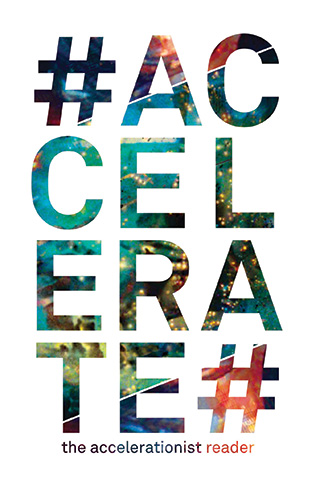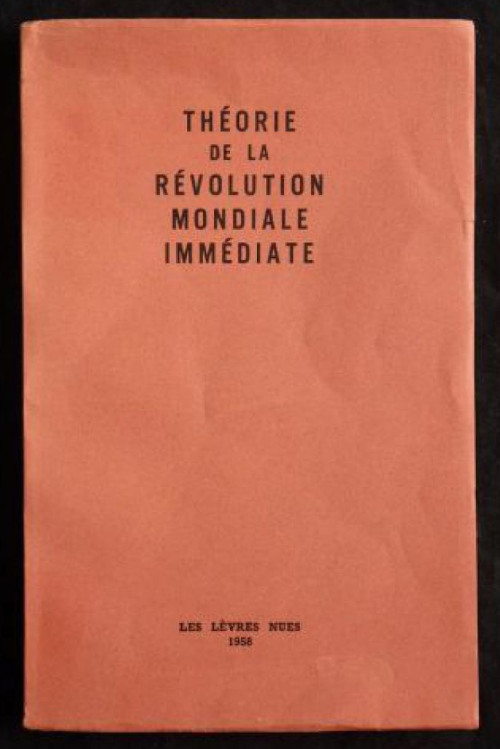Robin Mackay, Armen Avanessian (eds.), #Accelerate: The Accelerationist Reader (2014)
Filed under book | Tags: · accelerationism, capitalism, critique, cyberculture, labour, neoliberalism, politics, technology, theory

“Accelerationism is the name of a contemporary political heresy: the insistence that the only radical political response to capitalism is not to protest, disrupt, critique, or détourne it, but to accelerate and exacerbate its uprooting, alienating, decoding, abstractive tendencies.
#Accelerate presents a genealogy of accelerationism, tracking the impulse through 90s UK darkside cyberculture and the theory-fictions of Nick Land, Sadie Plant, Iain Grant, and CCRU, across the cultural underground of the 80s (rave, acid house, SF cinema) and back to its sources in delirious post-68 ferment, in texts whose searing nihilistic jouissance would later be disavowed by their authors and the marxist and academic establishment alike.
On either side of this central sequence, the book includes texts by Marx that call attention to his own ‘Prometheanism’, and key works from recent years document the recent extraordinary emergence of new accelerationisms steeled against the onslaughts of neoliberal capitalist realism, and retooled for the twenty-first century.
At the forefront of the energetic contemporary debate around this disputed, problematic term, #Accelerate activates a historical conversation about futurality, technology, politics, enjoyment and capital. This is a legacy shot through with contradictions, yet urgently galvanized today by the poverty of ‘reasonable’ contemporary political alternatives.”
Publisher Urbanomic, Falmouth, with Merve, Berlin, 2014
ISBN 9780957529557
536 pages
Reviews: Malcolm Harris (New Inquiry), J.J. Charlesworth (Art Review), Simon O’Sullivan (Mute), Alex Andrews (Review31), Orlando Read (Frieze).
Commentaries: McKenzie Wark (Public Seminar), David Cunningham (Radical Philosophy).
Heather Davis, Etienne Turpin (eds.): Art in the Anthropocene: Encounters Among Aesthetics, Politics, Environments and Epistemologies (2015)
Filed under book | Tags: · aesthetics, anthropocene, art, climate crisis, earth, ecology, environment, human, nature, politics, theory

“Taking as its premise that the proposed geologic epoch of the Anthropocene is necessarily an aesthetic event, this book explores the relationship between contemporary art and knowledge production in an era of ecological crisis, with contributions from artists, curators, theorists and activists.”
Contributors include Amy Balkin, Ursula Biemann, Amanda Boetzkes, Lindsay Bremner, Joshua Clover & Juliana Spahr, Heather Davis, Sara Dean, Elizabeth Ellsworth & Jamie Kruse (smudge studio), Irmgard Emmelhainz, Anselm Franke, Peter Galison, Fabien Giraud & Ida Soulard, Laurent Gutierrez & Valérie Portefaix (MAP Office), Terike Haapoja & Laura Gustafsson, Laura Hall, Ilana Halperin, Donna Haraway & Martha Kenney, Ho Tzu Nyen, Bruno Latour, Jeffrey Malecki, Mary Mattingly, Mixrice (Cho Jieun & Yang Chulmo), Natasha Myers, Jean-Luc Nancy & John Paul Ricco, Vincent Normand, Richard Pell & Emily Kutil, Tomás Saraceno, Sasha Engelmann & Bronislaw Szerszynski, Ada Smailbegovic, Karolina Sobecka, Zoe Todd, Richard Streitmatter-Tran & Vi Le, Anna-Sophie Springer, Sylvère Lotringer, Peter Sloterdijk, Etienne Turpin, Pinar Yoldas, and Una Chaudhuri, Fritz Ertl, Oliver Kellhammer & Marina Zurkow.
Publisher Open Humanities Press, 2015
Critical Climate Change series
Creative Commons BY-NC-ND 3.0 license
ISBN 1785420054, 9781785420054
402 pages
Review: Scott Volz (CAA Reviews, 2018).
PDF, PDF, PDF, PDF (12 MB)
More formats (Archive.org)
Marcel Marïen: Théorie de la révolution mondiale immédiate (1958) [French]
Filed under book | Tags: · advertising, capitalism, politics, revolution, spectacle

“Théorie de la revolution mondiale immediate was part of a triple issue of Marïen’s journal Les lèvres nues and ends its first series. It was later published as a stand-alone book. Its avowed purpose was “a sketch of an imaginary program for the overthrow of capitalism in every part of the world it controls, to be completed within a year, with a program applicable at any moment and everywhere at the same time.” (45)
The first half of the text is an analysis of contemporary capitalism under the shadow of nuclear annihilation. These days one might worry more about the Anthropocene, but rhetorically, the problem is similar: how to think a revolution at a time when it appears both absolutely necessary and extremely unlikely.
The first part is a sound analysis of the stage commodification had reached by the late fifties, And bears comparison with the better remembered texts of the time. The very success of the worker’s movement in its reformist form had produced a leisure culture. Workers were becoming petit-bourgeois in outlook. Technical change had raised up a cadre of educated workers. Communist propaganda no longer worked very well, whereas capitalist propaganda was making inroads into the unconscious of the working class.
The second part is more surrealist science fiction than social science. For the project there is to use the spectacle itself for revolutionary ends. The form of revolutionary organization is the advertising agency. It is to be called the Leisure Club. It creates advertising and popular media addressed to every diverse pastime, hobby or consumer preference – all to be worked out using the latest social science techniques. […]
While there are charming features of the book that date it, there are also many ways in which it is strikingly contemporary. As Sven Lütticken has pointed out, it is quite likely that former Tiqqun people borrowed the rhetoric of the Invisible Committee and the Imaginary Party from Mariën. One might also think it an anticipation of Adbusters, or even the strategies of Podemos in Spain, which seems to retain a model of the party of the interior while using contemporary marketing techniques.” (taken from McKenzie Wark’s 2016 essay)
Publisher Les Lèvres nues, 1958
111 pages
via Marcell via Ken
PDF (36 MB)
Comment (0)
